Social norms that put the burden of household work on women have led to the deaths and injuries of many women in rural Nepal.
BP Anmol | CIJ
What do women who have to spend their lives collecting fodder and firewood and toiling in the fields do? Usually, their dreams include remaining fit to work in the terraces and producing enough food to eat. Maybe these were also the dreams of Chandra Maya Phunyal, 55, of Bimeshwar Municipality in Dolakha District. She was healthy and had hardly ever visited a hospital. However, her life came to a halt when, on July 16, 2021, she fell off a tree she had climbed to collect animal fodder.
“I fell so hard that I could not even get up. It was only when my son came looking for me that I got help,” said Phunyal. “I was taken to the Dolakha Hospital first and then to Kathmandu for further treatment.”
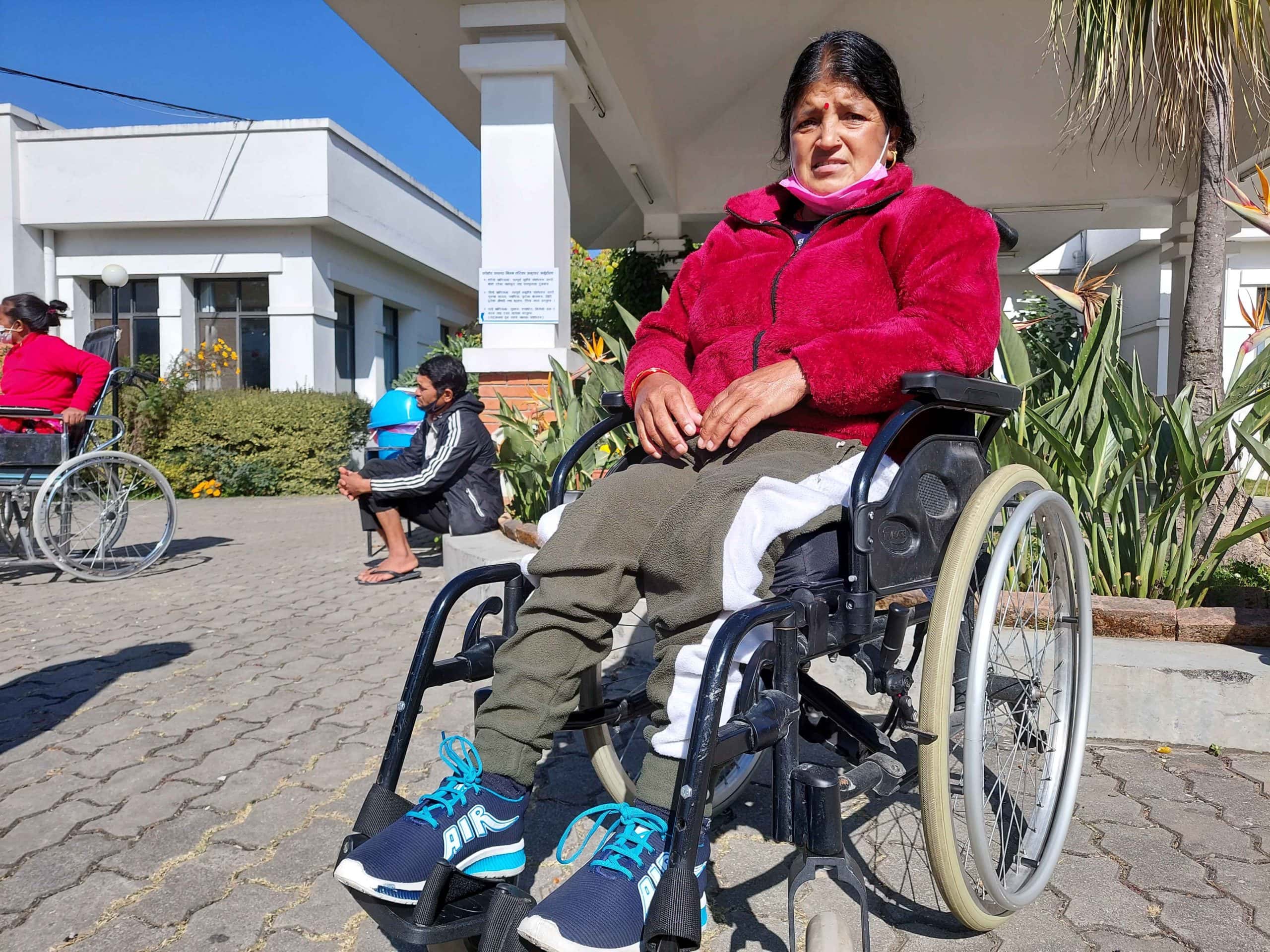
Chandra Maya Phuyal, 55, of Bhimeshwar Municipality of Dolakha was injured when she fell from a tree while cutting grass. Photo: BP Anamol
After being treated at B & B Hospital in Kathmandu, Phunyal was transferred to Spinal Injury Rehabilitation Centre at Sanga in Kavrepalanchok District. She has been paralysed below her waist, so she cannot walk. Doctors have already told her that she can’t walk again as she did before the accident.
Phunyal’s family, which depends on agriculture for sustenance, has already spent Rs2 million on her treatment. It has now mortgaged its land, among other things, to collect money for Phunyal’s treatment. “Our daughter is looking after the family now. We have faced a lot of trouble,” Phunyal said.
Phunyal has returned home after receiving physiotherapy and other forms of treatment at the centre but has not recovered fully.
The case of Humkala Nepali, 37, a resident of Dhurkot in Gulmi District, is not very different. On February 24, 2020, she met an accident when carrying stones at a construction site. Since she comes from a low-income family, she could not seek advanced medical help. She was treated at a hospital at the district headquarters, but she did not recover fully. When the coronavirus pandemic hit the country, she had to stay home, hoping that she would recover. But that was not to be.
local government is what the women need the most. However, the governments close to home have failed to work for the women. The helplessness of women due to a lack of access to resources.
-Meena Upreti, Sociologist
“Her spinal cord and ribs are broken. I underwent an operation at the Tamghas Hospital,” said Humkala, who is now undergoing treatment at the Spinal Injury Rehabilitation Centre at Sanga. “I had to sell my land to get treatment in the district. But I ended up staying home for two years since I had no other means to get treatment. I am getting better after coming here.”
Humkala, a mother of three, said she took financial support from others to visit the hospital at Sanga.
Due to the accident, she has been paralysed below her waist, and doctors have said she can’t recover fully. However, Humkala said she hopes to be able to use a wheelchair. She has now returned home after staying at the hospital for three months.
Madhu Kumari Magarati, 44, a resident of Teenpatan Rural Municipality in Sindhuli District, is in no different situation than Chandra Maya and Hum Kala. On September 12, 2021, she fell from a tree she had climbed to collect fodder for her goats. Her neighbours rescued her. She was treated at the Trauma Centre in Kathmandu for ten days, after which she received treatment at the Spinal Injury Rehabilitation Centre beginning September 21, 2021.
Madhu Kumari has been paralysed from below her waist. She has recovered partly but has no hopes of recovering fully. The responsibility of looking after the household has now come on her children. “I can now wear my clothes and go to the bathroom on my own,” said Magarati. She has now returned home after staying at the centre for five months.
‘Women’s work’ turns fatal
Chandra Maya, Hum Kala and Madhu Kumari are representative figures who have met with accidents while doing the tasks considered the ‘domain’ of women. This discrimination has not only led to injuries but also deaths of women. A study of the data released by the government shows how the situation is worrisome.
On October 27, 2021, a child was killed in Siraha District when she was buried under artificial earthen caves while five others were injured. In Dhangadhimai Municipality-5, Jayapur, Karishma Kumari, 11, was killed after being buried under artificial earthen caves, and five others were wounded.
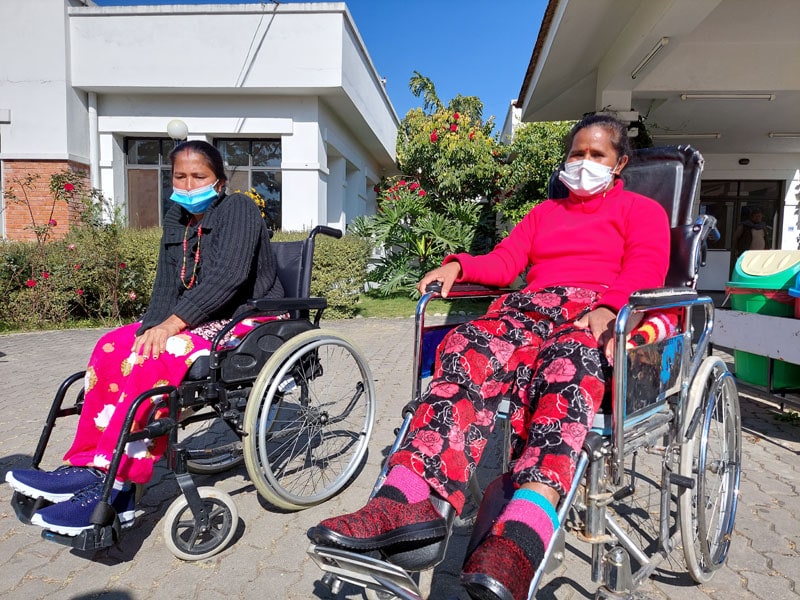
Madhukumari Magarati who was injured after falling from a tree and Humkala Nepali who was injured after she fell while carrying a house building stone. Photo: BP Anamol
The hazards caused by caving of earthen clay caves is not limited to Siraha district but is all-pervasive in many districts in Tarai and Inner Madhes. Those who are injured and killed are often women and girl children. For instance, on February 6, 2021, three women–Ganga Jaigadi, 31; Bhawana Oad, 20; and Dhansari Biswakarma, 17–were killed after being buried under artificial caves made through the extraction of earthen clay at Eastern Khairiphaant in Janaki Rural Municipality-9.
Another task that society has determined for women is that of cutting grass. But for exceptions, men are not engaged in this work. On September 12, 2021, Galu Devi Rawal, 60, a resident of Durgathali Rural Municipality-3, was killed when she fell off a cliff while cutting grass. On September 21, 2021, Sunita Pela, 24, a resident of Pancheswar Rural Municipality-5 in Baitadi District was killed when she fell off a cliff while cutting grass.
We provide relief to the victims, but we’ve failed to minimise the risks. We haven’t even been able to keep a record of the incidents happening within the municipality.
–Anchala Chaudhary, deputy mayor of Gauriganga Municipality in Kailali
Senior Superintendent of Police Durga Singh said many women are killed each year in accidents related to cutting grass or collecting earthen clay. “Women often meet with accidents because there is a misconception that tasks such as cutting grass and working in the field are the responsibility of women,” Singh said.
Although tasks such as crop plantation and harvesting are done with active support from men, many tasks related to agriculture and household are left to women. Although there are many tasks that women cannot do in safe conditions, they still have to do such tasks as the “strong class” of society does not care about such issues. In other words, women are being pushed to such risky tasks deliberately.
Sociologist Meena Uprety said women meet with accidents when they are sent to work without taking any precautions. “Our social structure has been making women do certain tasks even if they are risky,” said Uprety. She added that a criminal attitude that makes the women take up challenging tasks without caring for their physical safety has been putting women’s lives at risk.
‘Acts of no fault’ or murder? Household work kills 555 women in eight years.
On January 6, 2022, Leela Bista, 54, a resident of Rapti Sonari Rural Municipality in Banke District was killed in a tiger attack. She had gone to the Jalahan Community Forest to cut grass, and when she was reported lost, the police and the villagers went to search for her, only to find that she was already dead. The police had to fire in the air to dislodge her body from the grip of the tiger.
Two days earlier, Durga Tharu, a resident of Rapti Sonari-4, was attacked by a tiger when she had gone to the jungle to pluck Sal trees. But she defended herself against the tiger and came back alive. “I’d gone to the jungle with my friends. The tiger attacked me suddenly, and I fell to the ground. It had already got hold of my left hand and was about to attack me in the neck when I gathered the courage to attack its face with a sickle that was in my right hand. When the tiger stepped back, I shouted, and my friends came to my rescue. That is when the tiger ran away, and I was saved.”
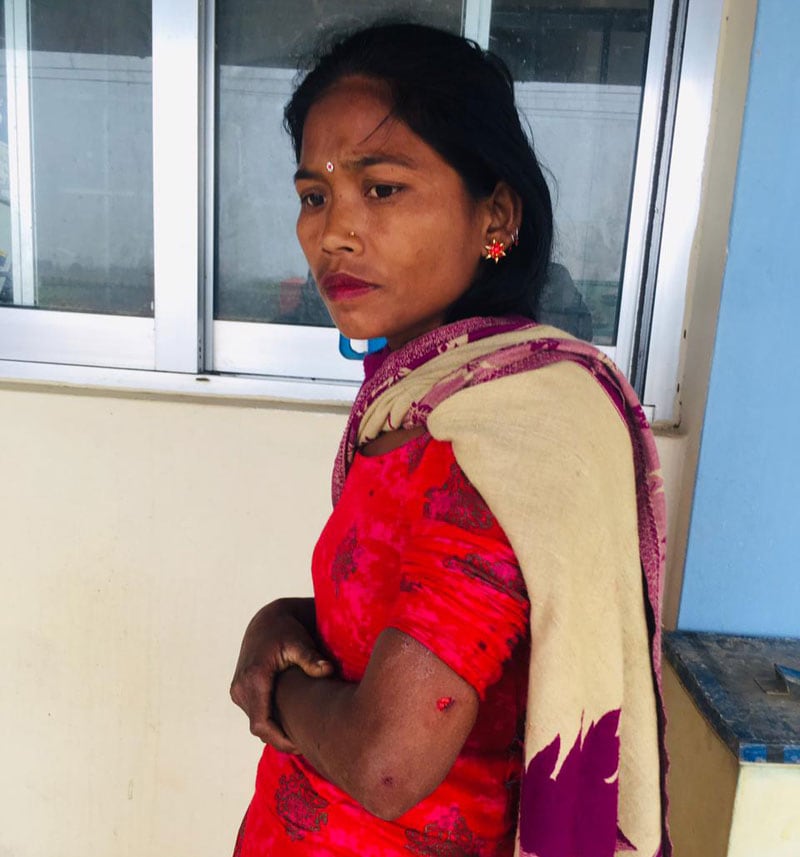
Durga Tharu, 30, of Rapti Sonari Gaonpalika (4) of Banke has managed to save her life after being attacked by a tiger. Photo: Hemanta Chaudhary
Several women are killed in attacks by wild animals each year. Several more are injured. What follows is an analysis of the problems that arise as a result of society imposing certain household chores on women.
173 women killed in wildlife attacks; 316 injured
Notwithstanding whether it is the hills o or the Terai, the jungle provides people with essential elements of a household, including firewood, grass, vegetables, leaves, and grassland. And, except for a few exceptions, these tasks fall on the shoulders of women. And this leads to wildlife attacks on women.
According to a record at the Police Headquarters, from mid-April 2013 to mid-December 2021, women have lost their lives in wild animal attacks. Similarly, 316 women have been injured. There are also girl children who have been killed or injured in wild animal attacks.

This data only incorporates the cases that have been registered at police offices across the country. Police officials say the number could be higher as many such attacks do not get registered with the police.
In the same dureation, 163 men have lost their lives in wild animal attacks. Although this number is less than that of women dying in similar incidents, the number of men getting injured is slightly higher. A total of 408 men were injured in wildlife attacks. But there is a reason why the status of women is dire as per the data.
Most women are attacked when they are working in the jungle or nearby. Some men are attacked while doing work such as cutting grass or collecting firewood, but many men are attacked when they are in the jungle to do things that are either recreational or illegal. These include the hunting of wild animals or the smuggling of logs. Data shows that while women are attacked when doing things out of compulsion, most men are attacked when doing unnecessary things.
According to Bishnu Prasad Shrestha, chief conservation officer at Bradiya National Park, a total of 16 individuals have been killed in incidents of wildlife attack. While four of them were killed in elephant attacks, 12 were killed in tiger attacks. “Women appear to be at a higher risk in terms of such incidents,” Shrestha said. “Women are attacked mostly when they are out in the jungle to cut grass, collect firewood or pick fiddlehead fern (niguro).”
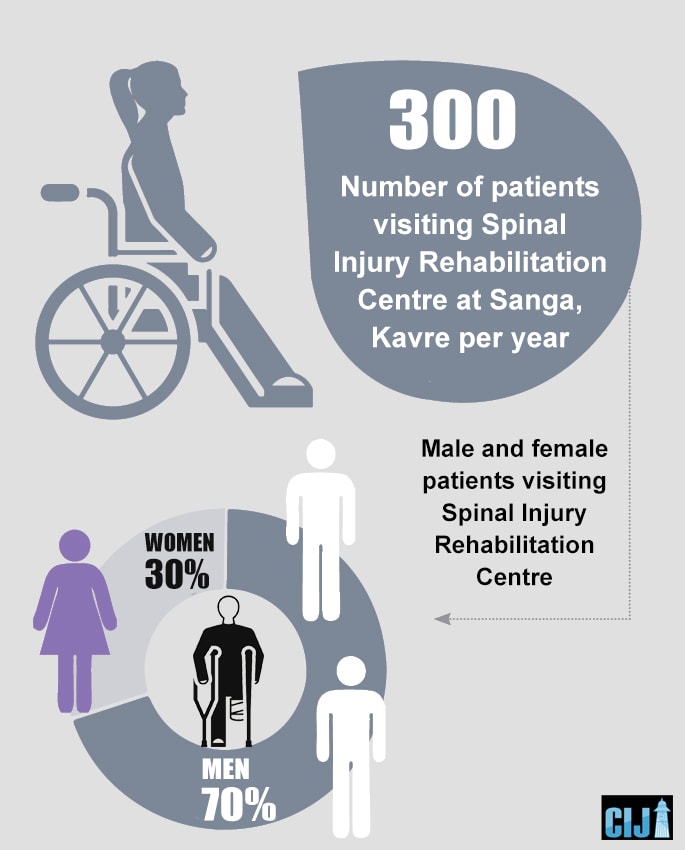
In the fiscal year 2019-20, out of six people killed in Bardiya National Park in wildlife attacks, four were women. This also shows how women are at a higher risk.
An official at Chitwan National Park also said women are attacked when they go to the jungle to cut grass, collect firewood or pick fiddlehead fern. However, except for Bardiya National Park, no other national park or conservation park seems to keep disaggregated data on the number of women and men killed in wildlife attacks.
According to Bed Kumar Dhakal, public information officer at National Parks and Wildlife Conservation Department, women face attacks when they go to the jungle to cut grass, collect firewood or pick fiddlehead fern because they are the ones who do these tasks. Such incidents happen in or around national parks. In terms of safety, women are more vulnerable because they cannot run like men when they come across wild animals.
82 women killed while extracting earthen clay; 123 injured
The daily life of most women is intrinsically dependent on earthen clay. Since a significant portion of the population is dependent on agriculture, it is not possible to imagine life without earthen clay. Moreover, most houses in rural areas are built with earthen clay, and it is essential to paint the house. Smearing floors and walls is also considered a sacred performance in rural areas. Bringing suitable earth for smearing the floor is considered women’s work. That is why women and girl children who fetch earthen clay face accidents while extracting earthen clay from the ground.
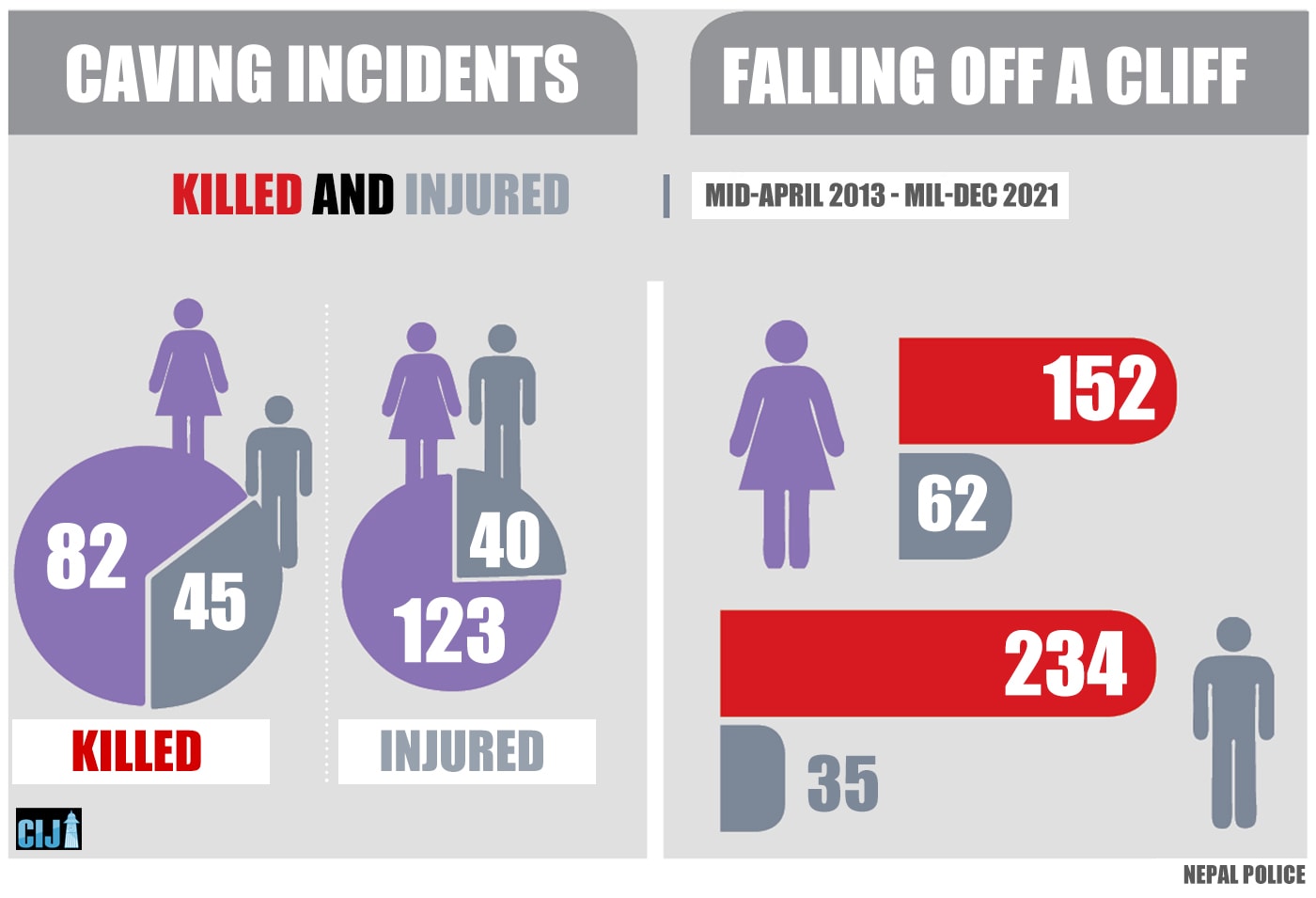
According to the Police Headquarters, 82 women have been killed in caving incidents in the past seven years while 123 others have been injured. Since this data included only those cases that have been registered with the police, the actual number of deaths and injuries could be higher. In the same duration, 45 men were killed after being buried under earthen clay caves, while 49 others were injured. The men who were killed or injured in caving incidents had faced professional hazards in projects such as road, irrigation, and hydroelectric projects.
152 women killed after falling off a cliff; 62 injured
Another hazardous work women are involved in is collecting grass or firewood from cliffs. There is no alternative to climbing cliffs to collect fodder and firewood in the hilly areas. And while doing so, several women lose their lives each year.
As per the data provided by Nepal Police, 152 women have been killed, while 62 others have been injured after falling off cliffs while doing household work.
In the same duration, 234 men have been killed and 35 injured. The reasons for such hazards faced by men, however, are different. They were either killed or wounded while roaming around in villages, returning home from the city, or walking in a drunken state.
69 women killed after falling off trees; 68 injured
It is not easy to collect grass suitable for cattle in rural areas. One has to cut grass on the edge of terraces or climb trees in the jungle. And while cutting the grass in such ways, 69 women have been killed and 68 injured in the past eight years. In the same duration, 142 men have been killed and 115 wounded.

According to Raju Dhakal, medical director at Spinal Injury Rehabilitation Centre in Sanga, most women who come to the centre have met with accidents while collecting grass or earth from caves. The centre is the only institution in Nepal that looks after patients suffering from a spinal injury. Almost 300 individuals visit the centre each year for treatment. Around 30 percent of such visitors are women.
In the past three years, 205 patients have received treatment at the centre. Out of them, 11 are girl children. According to Prajwal Ghimire, Coordinator of the Community Rehabilitation program at the Rehabilitation Centre, 90 percent of women and girl children who come to the centre for treatment meet with accidents while cutting grass, collecting firewood, or extracting earth.
“Men who come here are usually victims of road accidents. Whereas, women are victims of accidents related to household work,” Ghimire said.
79 women killed by snakebite; 226 injured
There are more areas where women face hazards due to discrimination in work. One such area is the risk of snakebite. According to the data provided by Police Headquarters, 79 women were killed in snakebite incidents between mid-April 2019 and mid-December 2021. Similarly, 226 women were injured in snakebite incidents. However, the number of such incidents could be higher. In the same duration, 73 men were killed in snakebite incidents, while 290 were injured.
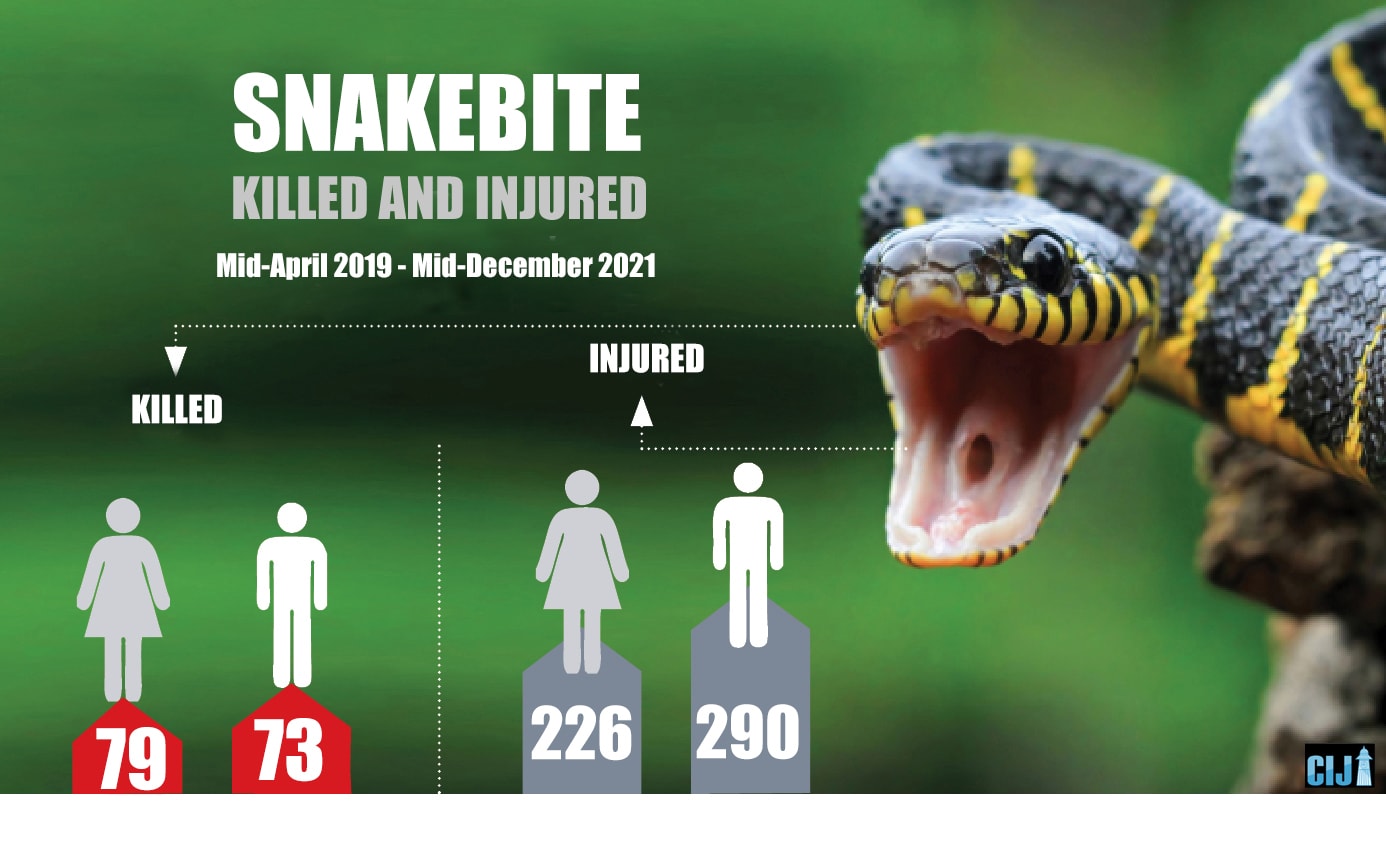
This data is from mid-April 2019 onwards, so the number appears lower. Women are seen to face snakebite hazards while extracting earth from caves, cutting grass, and collecting firewood.
The agony of those who survive
While a significant number of women are losing life while doing hazardous work, those who have to live with injuries have a tough time as well. The life cycle of the injured is disturbed. Not only are they unable to work, but they also have to face more trouble from family and society.
“If a woman is injured and impaired, she may not receive proper treatment and care,” said sociologist Uprety. “If a woman uses a wheelchair, the family might even ask her husband to remarry.”
Uprety added that a woman receives comparatively less care and attention if she becomes injured and impaired while doing hazardous work.
Hazard exacerbated by work discrimination
Lately, there have been discussions that the lives of women have changed. Several indicators are used to support such claims, for instance, the ownership of property, especially land and home. Several laws and policies have also helped increase women’s ownership of property. With this, the number of women “taking care of home” is increasing in a society that men dominate. And along with it, the workload of women in the household is rising.
Women often meet with accidents because there is a misconception that tasks such as cutting grass and working in the field are the responsibility of women,
Durga Singh, Senior Superintendent, Nepal Sentinel
Nowadays, many men from rural areas are heading to the city or abroad in search of work. In the absence of men, there is an additional burden on women to take up hazardous work. According to Senior Superintendent of Nepal Police Durga Singh, women taking up household work do not get even six hours of sleep a day. Due to excessive workload and a lack of nutritious food, women tend to become physically weak.” Singh said individuals, families and society should not burden women with hazardous work. “We must get rid of the idea that a certain kind of work is the burden of women. This situation won’t improve unless men are equally involved in household work.”
According to Uprety, the sociologist, the work considered the burden of women is often not considered financially rewarding. That is why society has a misconception that such work is no work—this misconception results in women not getting proper treatment and care when they meet with accidents.
Government remains clueless
When the constitution was promulgated in 2013, one of the significant things that made the people excited was the provision of powerful local governments that would deal with the local problems of the people. Because of this, the local government is called the government close to home. Keeping in mind the situation of the rural hinterlands, the local governments were given such a nomenclature. However, even as hundreds of women are killed or injured while doing household chores, the local governments remain clueless, leaving people wondering whether they are the governments close to home.
So much so that the local governments do not bother to find safer methods of extracting earthen clay when there are news reports that women are being killed or injured in caving incidents. When asked about the repeated caving incidents, Anchala Chaudhary, deputy mayor of Gauriganga Municipality in Kailali, conceded that the local government had ignored the problem. “We provide relief to the victims, but we’ve failed to minimise the risks. We haven’t even been able to keep a record of the incidents happening within the municipality.”
Phool Kumari Shrestha, deputy mayor of Dhangadhimai Municipality in Siraha, conceded that the local governments had failed to develop programs related to such incidents. She said that the municipality had not done much other than provide relief to the victims.
According to SSP Singh, the local governments should actively minimise such incidents because the ‘acts of no fault’ are related to social practices. Uprety said the local government is what the women need the most. However, the governments close to home have failed to work for the women. The helplessness of women due to a lack of access to resources, Uprety said, is also a part of the problem, and for that to change, the local governments should take initiatives.



